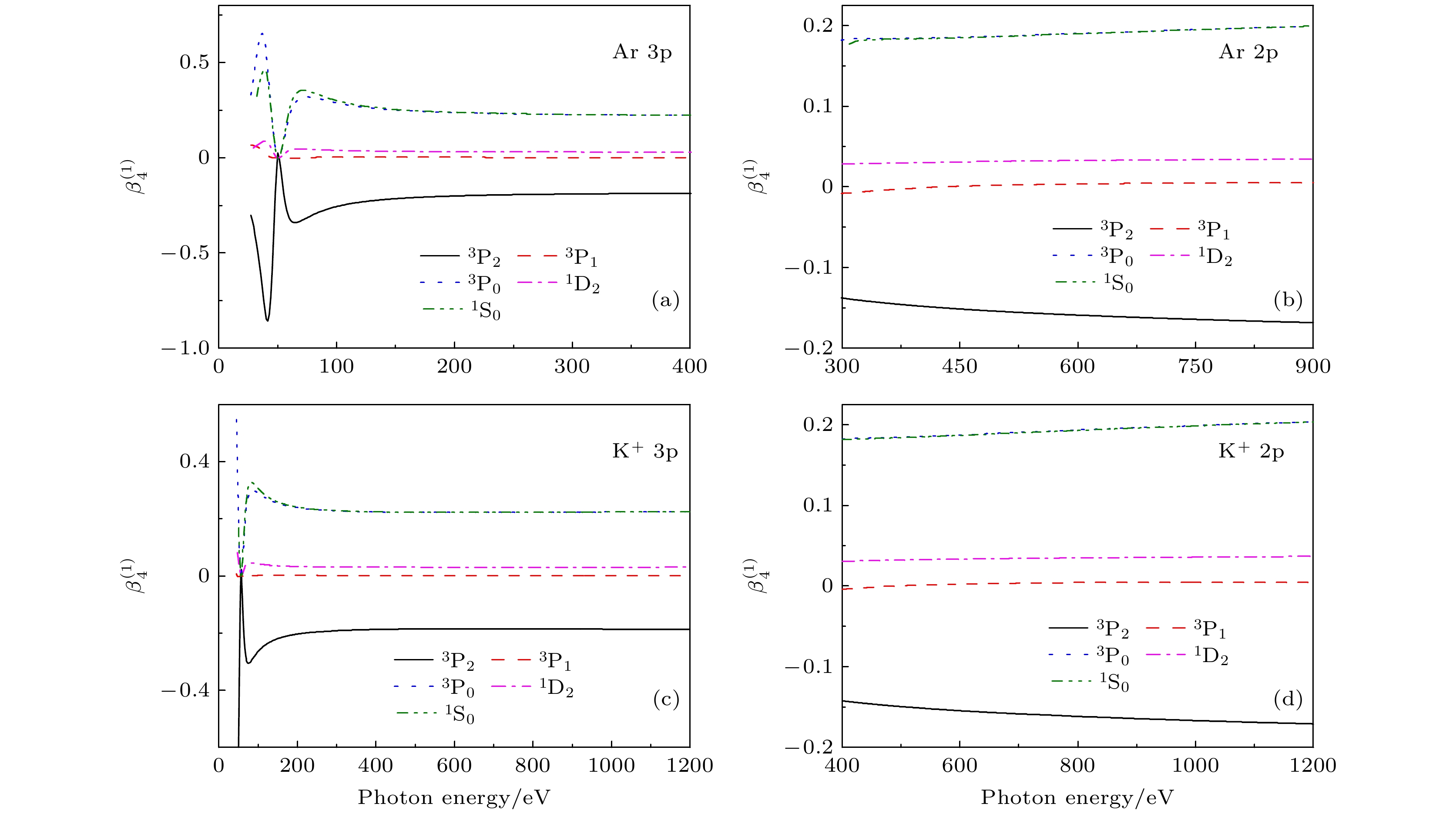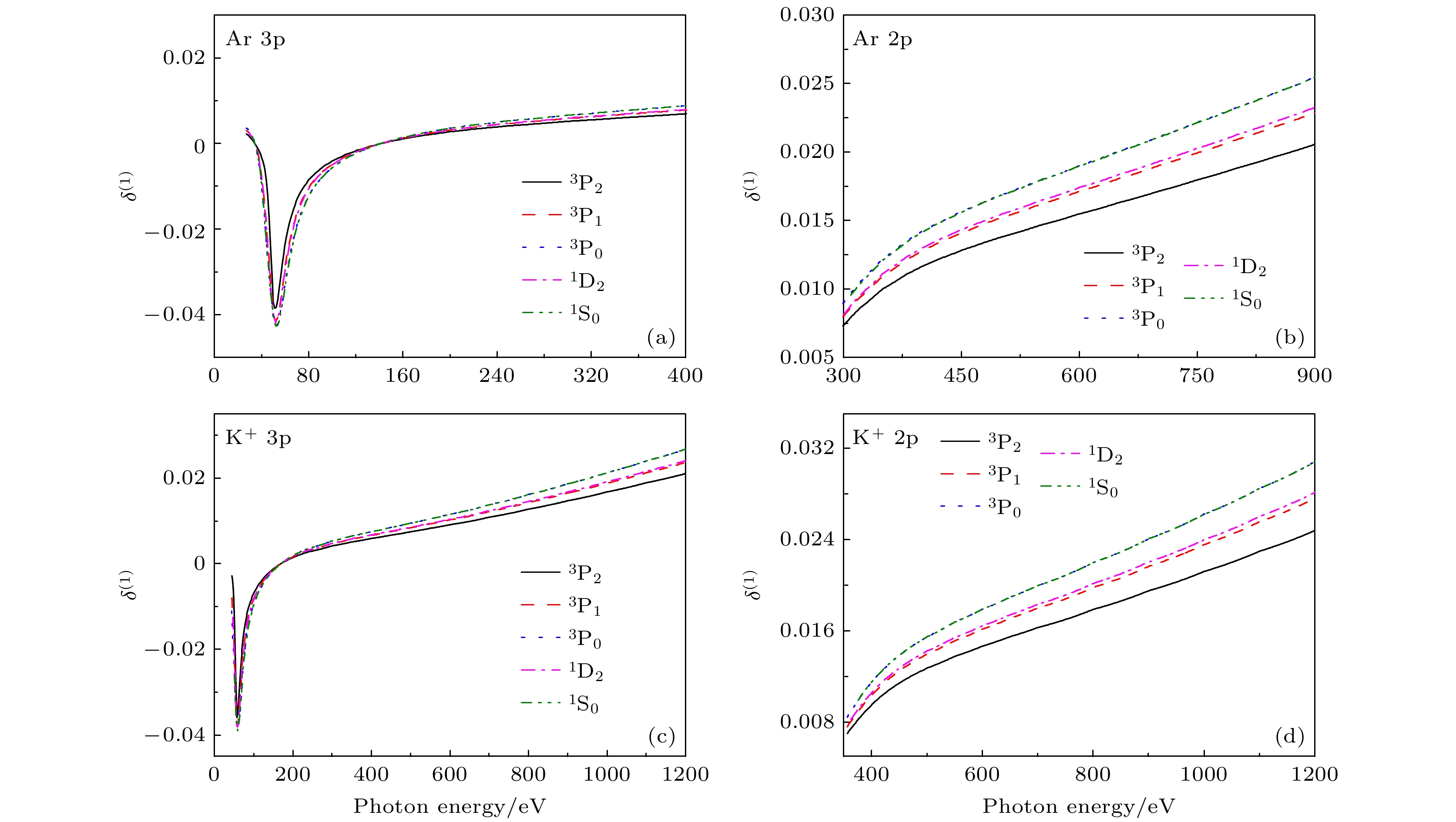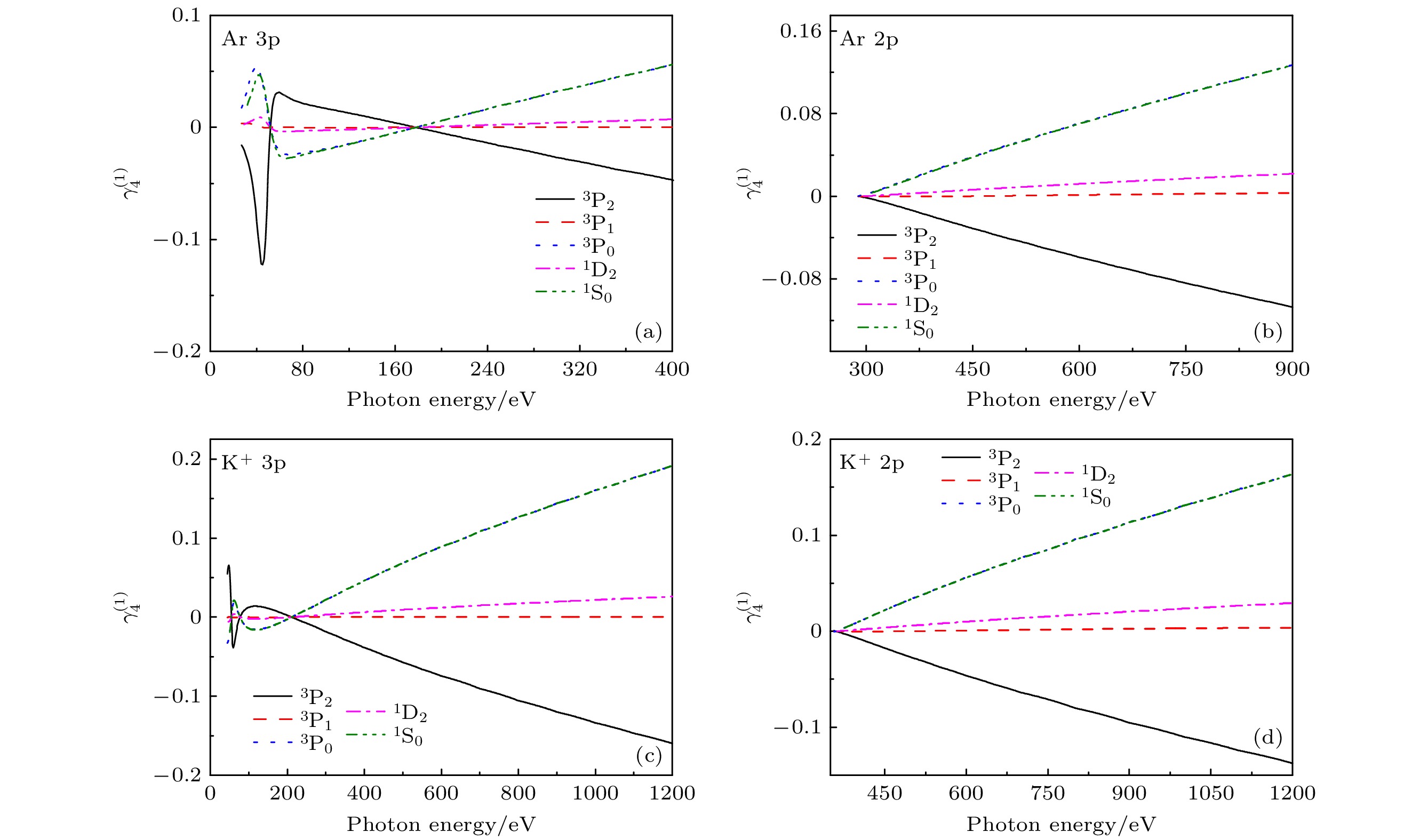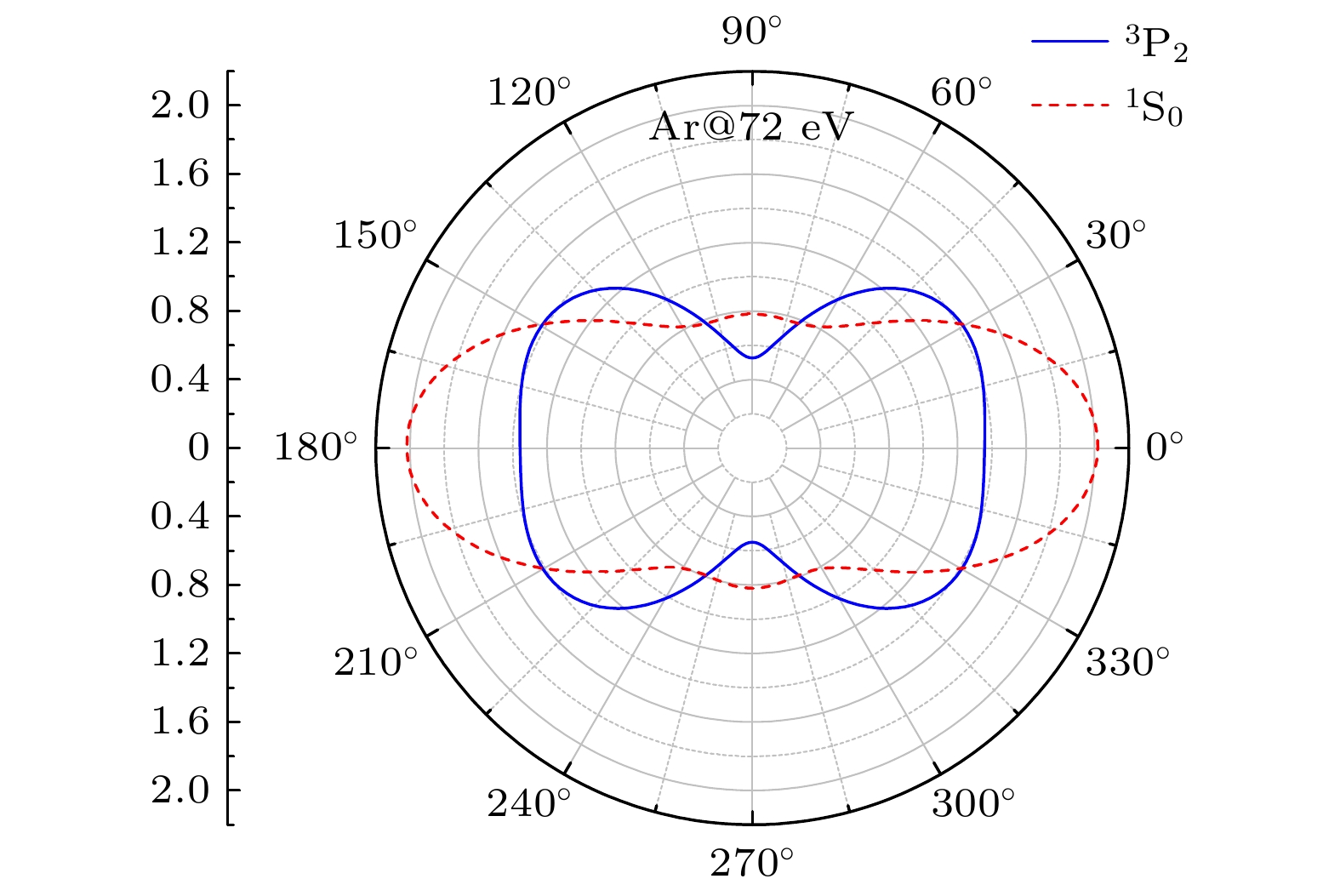-
基于多组态Dirc-Fock方法和密度矩阵理论, 给出了原子序列双光双电离光电子角分布的计算表达式, 开发了相应的计算程序. 利用该程序计算了Ar原子和K+离子np (n = 2, 3)壳层的光电离截面、电偶极和非偶极角各向异性参数, 进一步给出了光电子的角分布情况. 结果表明: 在序列双光双电离中两次光电离过程相互影响, 两次光电离的截面以及各向异性参数类似; 在电离阈值附近, 3p壳层和2p壳层光电离截面以及各向异性参数展现出较大的差异, 在远离阈值时, 3p和2p壳层的截面和角各向异性参数变化行为类似; 在光电离截面的Cooper极小能量位置, 电偶极的贡献被压制, 凸显出非偶极效应的贡献. 非偶极效应导致光电子相对于入射光方向出现前向-后向不对称分布.Owing to the development of XUV and X ray of the free-electron lasers, the photoelectron angular distribution in the sequential two-photon double ionization has received increasing attention of theorists and experimentalists, because it provides the valuable information about the electronic structure of atom or molecule systems and allows the obtaining of additional information about mechanisms and pathways of the two-photon double ionization. In this paper, the expression of the sequential two-photon double ionization process of the photoelectron angular distributions, including the non-dipole effects, is obtained based on the multi-configuration Dirac-Fock method and the density matrix theory, and the corresponding calculation code is also developed. Based on the code, the sequential two-photon double ionization process of the 3p and 2p shells of Ar atom and K+ ion are studied, in which, the dipole and the non-dipole parameters of photoelectron angular distribution are investigated systematically. It is found that the angular distributions of the first- and second-step electrons in sequential two-photon double ionization are similar and the two photoionization processes affect each other. Near the ionization threshold, the photoionization cross-sections and anisotropy parameters for the 3p shell and the 2p shell show a large difference. While away from the threshold, the cross-section and angular anisotropy parameters of the 3p and 2p shells show similar behaviors. At the position of Cooper minimum of the photoionization cross section, the contribution of the electric dipole is suppressed, and the non-dipole effect is obvious. The non-dipole effect leads to a forward-backward asymmetric distribution of photoelectrons relative to the direction of incident light. The results of this paper will be helpful in studying the nonlinear processes of photon and matter interaction in the XUV range.
-
Keywords:
- sequential two-photon double ionization /
- angular distribution of photoelectron /
- non-dipole effect
[1] Böhme D K 2011 Phys. Chem. Chem. Phys. 13 18253
 Google Scholar
Google Scholar
[2] Thissen R, Witasse O, Dutuit O, et al. 2011 Phys. Chem. Chem. Phys. 13 18264
 Google Scholar
Google Scholar
[3] Gillaspy J D, Pomeroy J M, Perrella A C, et al. 2007 J. Phys. Conf. Ser. 58 451
 Google Scholar
Google Scholar
[4] Ott C, Kaldun A, Raith P, et al. 2013 Science 340 716
 Google Scholar
Google Scholar
[5] Braune M, Reinköster A, Viefhaus J, et al. 2007 XXV Int. Conf. on Photonic, Electronic and Atomic Collisions (ICPEAC) Freiburg, Germany, July 25–31, 2007 Fr034
[6] Moshammer R, Jiang Y H, Foucar L, et al. 2007 Phys. Rev. Lett. 98 203001
 Google Scholar
Google Scholar
[7] Rudenko A, Foucar L, Kurka M, et al. 2008 Phys. Rev. Lett. 101 073003
 Google Scholar
Google Scholar
[8] Kurka M, Rudenko A, Foucar L 2009 J. Phys. B 42 141002
 Google Scholar
Google Scholar
[9] Augustin S, Schulz M, Schmid G, et al. 2018 Phys. Rev. A 98 033408
 Google Scholar
Google Scholar
[10] Braune M, Hartmann G, Ilchen M, et al. 2015 J. Mod. Opt. 63 1047422
 Google Scholar
Google Scholar
[11] Fukuzawa H, Gryzlova E V, Motomura K, et al. 2010 J. Phys. B 43 111001
 Google Scholar
Google Scholar
[12] Gryzlova E V, Ma Ri, Fukuzawa H, et al. 2011 Phys. Rev. A 84 063405
 Google Scholar
Google Scholar
[13] Ilchen M G, Hartmann G, Gryzlova E V 2018 Nat. Commun. 9 4659
 Google Scholar
Google Scholar
[14] Carpeggiani P A, Gryzlova E V, Reduzzi M 2019 Nat. Phys. 15 170
 Google Scholar
Google Scholar
[15] Kheifets A S 2007 J. Phys. B 40 F313
 Google Scholar
Google Scholar
[16] Fritzsche S, Grum-Grzhimailo A N, Gryzlova E V, Kabachnik N M 2008 J. Phys. B 41 165601
 Google Scholar
Google Scholar
[17] Gryzlova E V, Grum-Grzhimailo A N, Fritzsche S, Kabachnik N M 2010 J. Phys. B 43 225602
 Google Scholar
Google Scholar
[18] Krӓssig B, Jung M, Gemmell D S, Kanter E P, LeBrun T, Southworth S H, Young L 1995 Phys. Rev. Lett. 75 4736
 Google Scholar
Google Scholar
[19] Jung M, Krӓssig B, Gemmell D S, Kanter E P, LeBrun T, Southworth S H, Young L 1996 Phys. Rev. A 54 2127
 Google Scholar
Google Scholar
[20] Hemmers O, Fisher G, Glans P, Hansen D L, Wang H, Whitfield S B, Wehlitz R, Levin J C, Sellin I A, Perera R C C, Dias E W B, Chakraborty H S, Deshmukh P C, Manson S T, Lindle D W 1997 J. Phys. B 30 L727
 Google Scholar
Google Scholar
[21] Holste K, Borovik A A, Buhr T, Ricz S, Kövér Á, Bernhardt D, Schippers S, Varga D, Müller A 2014 J. Phys. Confer. Ser. 488 022041
 Google Scholar
Google Scholar
[22] 马堃, 颉录有, 张登红, 蒋军, 董晨钟 2016 65 083201
 Google Scholar
Google Scholar
Ma K, Xie L Y, Zhang D H, Jiang J, Dong C Z 2016 Acta Phys. Sin. 65 083201
 Google Scholar
Google Scholar
[23] Gryzlova E V, Grum-Grzhimailo A N, Staroselskaya E I 2015 J. Electron. Spectrosc. Relat. Phenom. 15 277
 Google Scholar
Google Scholar
[24] Grum-Grzhimailo A N, Gryzlova E V, Fritzsche S 2016 J. Mod. Opt. 63 334
 Google Scholar
Google Scholar
[25] 马堃, 颉录有, 董晨钟 2020 69 053201
 Google Scholar
Google Scholar
Ma K, Xie L Y, Dong C Z 2020 Acta Phys. Sin. 69 053201
 Google Scholar
Google Scholar
[26] Wang M X, Chen S G, Liang H, Peng L Y 2020 Chin. Phys. B 29 013302
 Google Scholar
Google Scholar
[27] Kiselev M D, Carpeggiani P A, Gryzlova E V, et al. 2020 J. Phys. B 53 244006
 Google Scholar
Google Scholar
[28] Varvarezos L, Düsterer S, Kiselev M D, et al. 2021 Phys. Rev. A 103 022832
 Google Scholar
Google Scholar
[29] Fritzsche S 2012 Comput. Phys. Commun. 183 1525
 Google Scholar
Google Scholar
[30] Jönsson P, Gaigalas G, Bieroń J, et al. 2013 Comput. Phys. Commun. 184 2197
 Google Scholar
Google Scholar
-
-
[1] Böhme D K 2011 Phys. Chem. Chem. Phys. 13 18253
 Google Scholar
Google Scholar
[2] Thissen R, Witasse O, Dutuit O, et al. 2011 Phys. Chem. Chem. Phys. 13 18264
 Google Scholar
Google Scholar
[3] Gillaspy J D, Pomeroy J M, Perrella A C, et al. 2007 J. Phys. Conf. Ser. 58 451
 Google Scholar
Google Scholar
[4] Ott C, Kaldun A, Raith P, et al. 2013 Science 340 716
 Google Scholar
Google Scholar
[5] Braune M, Reinköster A, Viefhaus J, et al. 2007 XXV Int. Conf. on Photonic, Electronic and Atomic Collisions (ICPEAC) Freiburg, Germany, July 25–31, 2007 Fr034
[6] Moshammer R, Jiang Y H, Foucar L, et al. 2007 Phys. Rev. Lett. 98 203001
 Google Scholar
Google Scholar
[7] Rudenko A, Foucar L, Kurka M, et al. 2008 Phys. Rev. Lett. 101 073003
 Google Scholar
Google Scholar
[8] Kurka M, Rudenko A, Foucar L 2009 J. Phys. B 42 141002
 Google Scholar
Google Scholar
[9] Augustin S, Schulz M, Schmid G, et al. 2018 Phys. Rev. A 98 033408
 Google Scholar
Google Scholar
[10] Braune M, Hartmann G, Ilchen M, et al. 2015 J. Mod. Opt. 63 1047422
 Google Scholar
Google Scholar
[11] Fukuzawa H, Gryzlova E V, Motomura K, et al. 2010 J. Phys. B 43 111001
 Google Scholar
Google Scholar
[12] Gryzlova E V, Ma Ri, Fukuzawa H, et al. 2011 Phys. Rev. A 84 063405
 Google Scholar
Google Scholar
[13] Ilchen M G, Hartmann G, Gryzlova E V 2018 Nat. Commun. 9 4659
 Google Scholar
Google Scholar
[14] Carpeggiani P A, Gryzlova E V, Reduzzi M 2019 Nat. Phys. 15 170
 Google Scholar
Google Scholar
[15] Kheifets A S 2007 J. Phys. B 40 F313
 Google Scholar
Google Scholar
[16] Fritzsche S, Grum-Grzhimailo A N, Gryzlova E V, Kabachnik N M 2008 J. Phys. B 41 165601
 Google Scholar
Google Scholar
[17] Gryzlova E V, Grum-Grzhimailo A N, Fritzsche S, Kabachnik N M 2010 J. Phys. B 43 225602
 Google Scholar
Google Scholar
[18] Krӓssig B, Jung M, Gemmell D S, Kanter E P, LeBrun T, Southworth S H, Young L 1995 Phys. Rev. Lett. 75 4736
 Google Scholar
Google Scholar
[19] Jung M, Krӓssig B, Gemmell D S, Kanter E P, LeBrun T, Southworth S H, Young L 1996 Phys. Rev. A 54 2127
 Google Scholar
Google Scholar
[20] Hemmers O, Fisher G, Glans P, Hansen D L, Wang H, Whitfield S B, Wehlitz R, Levin J C, Sellin I A, Perera R C C, Dias E W B, Chakraborty H S, Deshmukh P C, Manson S T, Lindle D W 1997 J. Phys. B 30 L727
 Google Scholar
Google Scholar
[21] Holste K, Borovik A A, Buhr T, Ricz S, Kövér Á, Bernhardt D, Schippers S, Varga D, Müller A 2014 J. Phys. Confer. Ser. 488 022041
 Google Scholar
Google Scholar
[22] 马堃, 颉录有, 张登红, 蒋军, 董晨钟 2016 65 083201
 Google Scholar
Google Scholar
Ma K, Xie L Y, Zhang D H, Jiang J, Dong C Z 2016 Acta Phys. Sin. 65 083201
 Google Scholar
Google Scholar
[23] Gryzlova E V, Grum-Grzhimailo A N, Staroselskaya E I 2015 J. Electron. Spectrosc. Relat. Phenom. 15 277
 Google Scholar
Google Scholar
[24] Grum-Grzhimailo A N, Gryzlova E V, Fritzsche S 2016 J. Mod. Opt. 63 334
 Google Scholar
Google Scholar
[25] 马堃, 颉录有, 董晨钟 2020 69 053201
 Google Scholar
Google Scholar
Ma K, Xie L Y, Dong C Z 2020 Acta Phys. Sin. 69 053201
 Google Scholar
Google Scholar
[26] Wang M X, Chen S G, Liang H, Peng L Y 2020 Chin. Phys. B 29 013302
 Google Scholar
Google Scholar
[27] Kiselev M D, Carpeggiani P A, Gryzlova E V, et al. 2020 J. Phys. B 53 244006
 Google Scholar
Google Scholar
[28] Varvarezos L, Düsterer S, Kiselev M D, et al. 2021 Phys. Rev. A 103 022832
 Google Scholar
Google Scholar
[29] Fritzsche S 2012 Comput. Phys. Commun. 183 1525
 Google Scholar
Google Scholar
[30] Jönsson P, Gaigalas G, Bieroń J, et al. 2013 Comput. Phys. Commun. 184 2197
 Google Scholar
Google Scholar
计量
- 文章访问数: 7685
- PDF下载量: 93
- 被引次数: 0
















 下载:
下载:

















